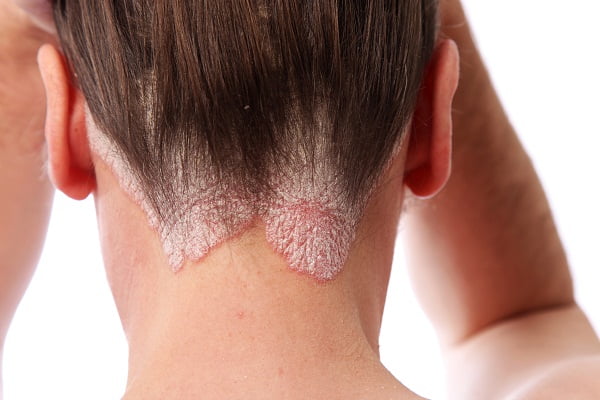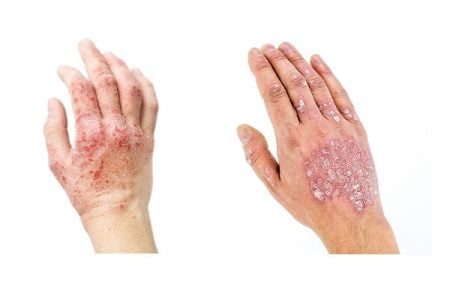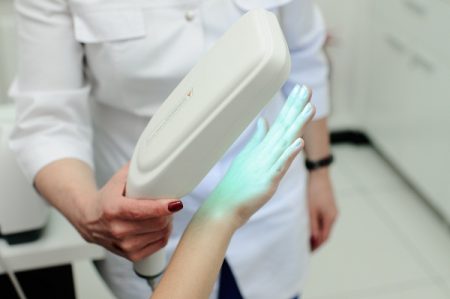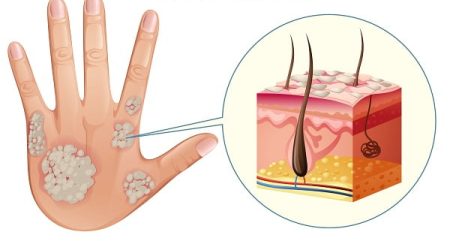Signs and Symptoms of Psoriasis
- Updated on: Jul 12, 2024
- 6 min Read
By
- Published on Oct 3, 2019


What are the symptoms of psoriasis?
The signs and symptoms of psoriasis vary from patient to patient, but they are more or less similar in different types of psoriasis. In the majority of cases, patients have cyclical symptoms (problems occurring for a particular period of time, and then easing or disappearing for a while, and then again reoccurring).
Even though it is possible to sometimes have two types occurring simultaneously, in most of the cases, patients generally have just one form of psoriasis at a time. The symptoms and signs of different types of psoriasis are discussed below:
Symptoms of Plaque Psoriasis
It is the most common form of psoriasis. Plaque psoriasis causes dry, red skin lesions (plaques) covered with silvery scales. The symptoms of plaque psoriasis are:
- Raised, inflamed, reddish patches on the skin called plaque
- A silvery-white coating called scale cover the patches
- Patches can appear in regular or irregular patterns, anywhere on the skin
- Mostly, patches appear on the knees, elbows, lower back, and scalp
- Patches are typically itchy or sore or both
- Scratching the affected area or patch causes the patches to thicken and eventually bleed
- Patches vary in size and shape. They can appear as separate patches or join together to cover a large area. They can be of any irregular shape.
- The skin around the joints may crack and bleed in severe cases.
Symptoms of Nail Psoriasis
Nail psoriasis can affect fingernails and toenails, causing pits on the nails, which often become thickened and yellowish. Following are the symptoms of nail psoriasis:
- Discoloring – The color of the nail changes to yellow-red. It looks like a drop of oil (or blood) under the nail plate. Healthcare professionals sometimes refer this as an oil drop or salmon patch.
- Pitting of the nail matrix – Due to the loss of cells from the surface of the nail, pits appear on them
- Lines across the nails – Health care professionals often call it Beau-line. Horizontal lines (side-to-side) appear on the nails, which are caused by inflammation of the cells.
- Leukonychia – It is also known as mid-matrix disease white nails or milk spots. It is a medical term for white discoloration appearing on nails. It is derived from the Greek words leuko (“white”) and nychia (“nails”).
- Subungual hyperkeratosis – It is a type of skin disorder in which the excessive skin cells which are reproduced, accumulate between the nail and the nail bed (the small piece of skin of the finger on which the nail rests). It also involves thickening and lifting of the nail.
- Nail Hyponychium – The nail separates from the nail bed and a yellowish white area develops which starts at the tip of the nail and extends downwards. The nail loosens and the skin of the nail bed becomes infected.
- Nail crumbling – Due to psoriasis, the structures that support the nail may not work properly, and the nail weakens. This condition is referred to as plate crumbling at the nail bed.
- Splinter hemorrhage – Some small horizontal black lines extend from the tip of the nail to the cuticle. Tiny capillaries (which are very small blood vessels) between the nail and your skin under it may bleed.
- Spotted lunula – Lunula is the light colored half moon shape that forms at the base of your nail, where the matrix connects with the nail bed.It becomes red when the blood vessels under the nail are congested.
- Nail changes with arthritis in the fingers. At least half of all patients with psoriatic arthritis experiences nail changes.
- Onychomycosis – It is a fungal infection of the nail. In this type of infection, toenails are affected more than the fingernails.
- Paronychia – It is a bacterial or fungal infection of the hand or foot where the nail and skin meet at the side or the base of the finger.
Symptoms of Scalp Psoriasis
The scalp is the most common place for people with psoriasis to get a rash. Scalp psoriasis affects approximately 50% of the patients. The symptoms are described below:
- Reddish patches on the scalp – Red patches can be barely noticeable or can be very noticeable, thick, and inflamed.
- Dandruff-like flaking and silvery-white scale – Scalp psoriasis can look a lot like dandruff. Many people who have scalp psoriasis see flaking. But scalp psoriasis is quite different from dandruff. Scalp psoriasis causes a silvery sheen and dry scale on the scalp, while dandruff is shedding of the dead skin cells of the scalp.
- Dry scalp – Due to dryness on the scalp, the skin cracks, and bleeds.
- Itching – This is one of the most common symptoms. Itching can be mild in the beginning but gradually it becomes intense that can interfere with everyday life and cause sleepless nights.
- Bleeding – Because scalp psoriasis can be very itchy, almost everyone scratches. Scratching can make the scalp bleed. Scratching also tends to worsen psoriasis. Scratching can make the patches larger and thicker and should be avoided.
- Burning sensation or soreness – The scalp can burn. It can feel extremely sore.
- Temporary hair loss – Scratching the scalp or using force to remove the scale can cause hair loss. Once the scalp psoriasis clears, hair usually regrows.
Symptoms of Guttate Psoriasis
This type of psoriasis primarily affects young adults and children. It is not very common and is seen only in lesser than 2 percent of all psoriasis cases. Symptoms of guttate psoriasis are:
- Small, pink or red colored spots form. These are not more than 1 cm in diameter and usually appear suddenly on the skin two to three weeks after a throat infection.
- The outbreaks are fairly widespread which may develop anywhere on the body, arms, or legs and sometimes spreads to the face, ears, or scalp. The palms and the bottoms of the feet are not usually affected.
- The drop-like lesions are usually itchy
- Some signs and symptoms of nail psoriasis may also be present
- Spots may go in a few weeks or months even without treatment.
- Spots may show up again where the person had plaque psoriasis earlier.
- Guttate psoriasis may disappear completely if treated properly. However, some young patients may eventually develop plaque psoriasis.
Symptoms of Inverse Psoriasis
Inverse psoriasis, also referred as intertriginous psoriasis, is an unusual type of psoriasis that occurs in skin folds located in the armpits, in the groin, under the breasts and around the genitals. Following are the symptoms of inverse psoriasis:
- Inflamed, bright red, smooth patches of skin.
- Can be very itchy and painful
- Patches only develop where skin touches skin, such as the armpits, around the groin, genitals, and skin between the buttocks. Women can develop a red, raw patch under their breasts.
- More common among overweight/obese individuals, symptoms are seen under the belly (where it folds over).
- Sweating in the skin folds and skin rubs may aggravate affected areas.
- Skin feels very sore where inverse psoriasis appears.
Symtoms of Pustular Psoriasis
Pustular psoriasis (also called von Zumbusch psoriasis) is a rare and sometimes fatal form of psoriasis. It can occur on your hands, feet or fingertips either in smaller sections or may be widely spread. Its symptoms are:
- Bright-red skin, swollen and dotted with pus-filled bumps is developed.
- Bumps generally appear only on your palms and feet soles.
- Soreness and pain where the bumps appear is common.
- Pus-filled bumps will dry, and leave behind brown dots and/or scales on the skin.
The patient suffering from pustular psoriasis may have:
- Fever and chills
- Been feeling sick and exhausted.
- Severe itching.
- Rapid pulse.
- Loss of appetite.
- Weakness.
Symptoms of Erythrodermic Psoriasis
It is the least common of all psoriasis types. Erythrodermic psoriasis can cover your entire body with a red, peeling rash that can itch or burn too much. The symptoms may include:
- The whole body can be covered with a fiery red rash and the skin looks like it is burned.
- Skin may appear bright red.
- The patient suffers from hypothermia. The body cannot maintain its normal temperature of 98.6° F.
- Heart beats too fast.
- Intense itching and severe pain
- Intense burning sensation
- Severe redness on the skin
- Shedding of skin over a large area of the body
- Exfoliation often occurs in large sheets instead of smaller scales, during which itching, burning, and swelling are more severe.
- Body is more susceptible to losing proteins and fluid, leading to dehydration and malnutrition (as well as heart failure).
Symptoms of Psoriatic Arthritis
It affects approximately 10-30% of those with skin symptoms. The arthritis is usually in the hands and feet and, occasionally in the large joints. The symptoms are as under:
- Most of the patients first develop psoriasis and then are diagnosed with psoriatic arthritis at a later stage. However, arthritis may also sometimes develop before the skin lesions appear. Read about diagnosing psoriasis.
- Redness, swelling around the affected joints
- Finger(s) swells around the affected joints and tendons
- Restricted movement at the affected joint
- Symptoms of nail psoriasis can also be seen
- Flaking silver patches of skin. Inflammation under the skin is usually red.
- Iritis – inflammation of the iris. The eye becomes reddened. There may be sensitivity to light.
- Uveitis – inflammation involving the uvea – the iris, choroid, and ciliary body (parts of the eye). Redness of the eye, blurred vision, sensitivity to light, and eye pain are the main symptoms.
- Spondylitis – Inflammation of one or more of the vertebrae of the spine. Inflammation can also occur where ligaments and tendons are attached to the spine. Pain and stiffness in the lower back, upper buttock area, neck, and other portions of the spine is observed. Symptoms are usually worse when you wake up, or after long periods of inactivity or after resting.
- Pain and stiffness in and around your joints
- Pain and swelling in your heels, caused by inflammation where the Achilles tendon attaches to the bone
- Pain in other areas such as your knee, hip, and chest
- Fatigue, which can be caused by an activity and the emotional effects that come with living with a long-term condition.












1 Comment
It’s nice that you mentioned how the signs and symptoms of psoriasis are different between patients. I was talking with my coworker yesterday and I heard his younger brother has psoriasis. Fortunately, there are psoriasis medical skin treatments now, so they should see a specialist immediately.